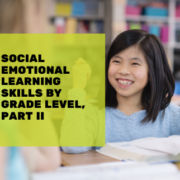Social Emotional Learning Skills by Grade Level, Part II
As discussed in part one, social emotional learning (SEL) skills have become an even greater focus now that students are limited in their opportunities to socialize, collaborate, and communicate with peers in person at school. We all know that academics are just one facet of education; the SEL skills that students learn and develop when in school are just as critical. Some might even argue that these “street smarts” are more important or beneficial than the “book smarts” we acquire in school. That said, distance learning and virtual schooling have certainly created various obstacles for students when it comes to developing and growing their SEL skills. Below is our continued list of specific grade-level SEL standards.
Later Elementary Grades (4-5)
- Students in 4th and 5th grade should be able to assess a range of feelings and emotions connected to specific scenarios, circumstances, and situations. In other words, they should be able to thoroughly describe how they feel and precisely what made them feel this way.
- Students should be able to maintain control of certain behaviors and/or emotions that might interfere with their focus. For example, if they are feeling stressed about their homework, they should choose to turn off the television and put the phone away until they finish their assignments.
- Students should be able to articulate interests, goals, and the ways in which to develop the necessary skills to achieve those goals.
- Students in the later elementary grades should be able to list the necessary steps for goal setting and future achievement while monitoring personal progress throughout the process. In other words, they should be able to take an active role by tracking growth and taking steps to improve along the way.
- Students should begin to understand social cues that demonstrate how others are feeling during certain situations.
- Students should be able to not only recognize others’ perspectives, but specifically describe another’s perspective or stance as well. They should be using phrases like, I understand what you’re feeling and why you’re feeling that way. I might disagree with you, but I appreciate your point of view. That’s not how I interpreted it, but I can see how you may have experienced it differently.
- Students should be able to engage in positive interactions with people from different backgrounds and those with different opinions and beliefs.
- In the late elementary grades, students should begin to understand various cultural differences between groups, i.e., they should acknowledge that not everyone celebrates Christmas.
- 4th and 5th graders should be able to describe various approaches to meeting new people and maintaining friendships while forging new friendships with peers in different social circles.
- Students should begin to demonstrate self-respect and how to show respect to others, even during conflicts or disagreements; they choose their words wisely as to not offend others in the heat of the moment.
- Elementary schoolers should begin to understand different social cues and behaviors of others and how they might impact one’s decision making.
- Once reaching the late elementary grades, children should be able to brainstorm various options for solving a problem and anticipating the different outcomes depending on the situation.
- Finally, 4th and 5th grade students should be able to identify needs in their school/local environment and perform duties to contribute to these communities. For example, if the cafeteria floor is covered in trash, they will take it upon themselves to help clean up after others.





